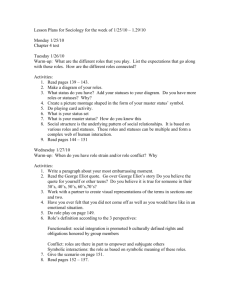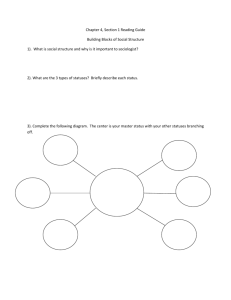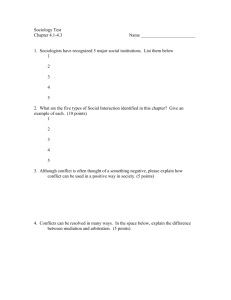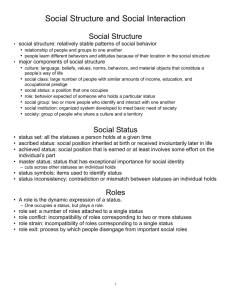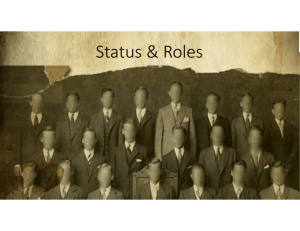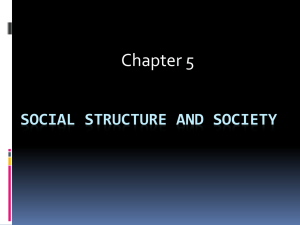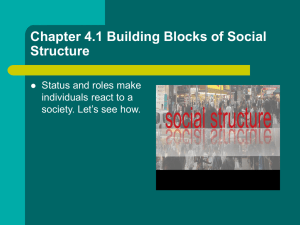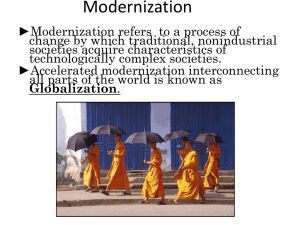File - Yesenia King
advertisement
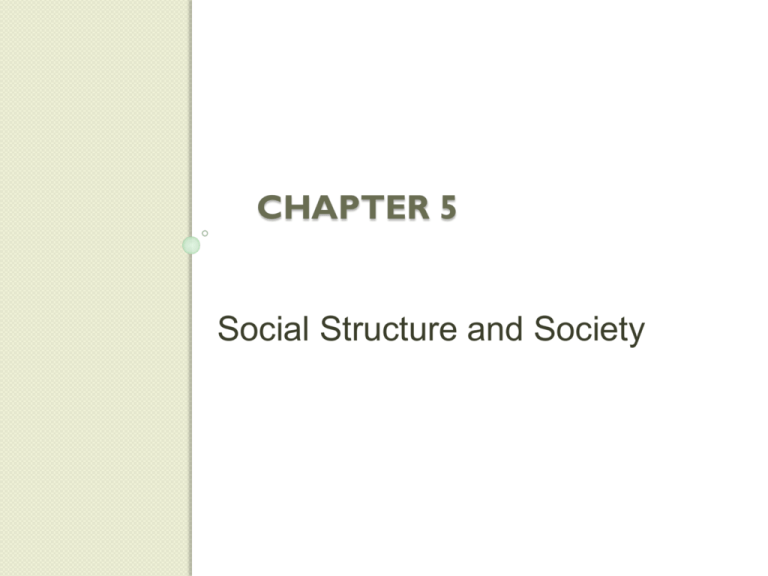
CHAPTER 5 Social Structure and Society Social Structure Social structure - the underlying pattern of social relationships that persist over time. Sociological Significance of Social Structure ◦ Guides Our Behavior ◦ Behavior Decided by Location in Social Structure ◦ Example: Social Class Divides People by… Income Education Occupational Prestige Status Status – a position that a person occupies within a social structure. Individuals in interrelated statuses usually behave in orderly and predictable ways. Status helps us define who and what we are in relation to others within the same social structure. Prestige Statuses may be assigned or earned. Types of Status A status set is all the statuses that an individual occupies at a particular time ◦ Individuals occupy many statuses at once as well as throughout their life course. Ascribed status – inherited at birth or receives involuntarily later in life. ◦ Examples: race, social class of parents Achieved status – earned, accomplished, or involve at least some effort or activity on the individual’s part ◦ Examples: college president or bank robber Types of Status Master status – affects/influences most other aspects of a person’s life. Cuts across all other statuses that an individual occupies. The Interrelationships of Social Statuses Roles Roles - culturally defined behaviors, rights, obligations, and priveleges attached to social statuses; the expected behaviors attached to a status. Role sets – all of the roles that are attached to a single status. As you can see, the structure gets complex, as a person can have many role sets that are associated with the many statuses of their status set. Role Conflict & Role Strain Role conflict occurs when the expectations attached to one status are incompatible with the expectations of another status – in other words, conflict between roles. Mom & doctor Role strain occurs when the roles of a single status are inconsistent; conflict that someone feels within a role. Example: Student with multiple tests Role Strain Role Conflict Roles are an essential component of culture because they lay out what is expected of people, and as individuals perform their roles, those roles mesh together to form a society. Types of Society Society – composed of people living within defined territorial borders, sharing a common culture. Societies become more complex as the means for solving subsistence problems improve. Major types of societies are hunting and gathering, horticultural, pastoral, agricultural, industrial, and postindustrial. Comparison of Major Types of Society: Hunting and Gathering Pastoral and Horticultural Agricultural Industrial Postindustrial The Social Transformations of Society Differences between Preindustrial and Industrial Societies Tönnies (1887) distinguished between: gemeinschaft, based on tradition, kinship, and intimate social relationships, gesellschaft, based on weak family ties, competition, and less personal social relationships. Durkheim (1893) also identified two types of society by looking at their social solidarity. Mechanical solidarity – foundation for social unity; achieves this through a consensus of beliefs, values, and norms; strong social pressures for conformity and dependence on tradition and family. Organic solidarity – achieves social unity through complex specialized statuses that make members interdependent. Dependence and need for cooperation replace the homogeneity of beliefs, values, and norms characteristic of simpler societies. Robert Redfield (1941) made a distinction between folk society and urban society. Folk society – rests on tradition, cultural and social consensus, family, personal ties, little division of labor, and an emphasis on the sacred. Urban society – social relationships are impersonal and contractual; the importance of the family declines; cultural and social consensus is diminished; economic specialization becomes even more complex; and secular concerns outweigh sacred ones. Major Features of Postindustrial Society Economic base is grounded more in service industries than in manufacturing. Relies on expertise in production, consumption, and government. Bell (1999) identifies five major features of postindustrial society: 1. Majority of labor force is employed in services rather than agriculture or manufacturing. 2. White-collar employment replaces blue-collar work. 3. Theoretical knowledge is the key organizing feature. 4. Through new means of technological forecasting, society can plan and control technological change. 5. Intellectual technology dominates human affairs. Modernization and the Theoretical Perspectives Modernization – entails the broader social changes that accompany economic development based on industrialization. According to modernization theory, the changes associated with modernization are the result of an evolutionary process by which societies become increasingly complex. Modernization and the Theoretical Perspectives Broader societal changes that accompany modernization: ◦ population growth ◦ life expectancy increases ◦ death rate declines Modernization brings an expanded upper and middle classes, with more emphasis placed on personal achievement. Modernization promotes political democracy. Modernization transfers education from the family to formal schooling. Modernization affects family life. Convergence Advocates of convergence foresee the development of social and cultural similarities among modernizing nations. ◦ This leads to the creation of a global culture – a homogenized way of life spread across the globe. Divergence Supporters of divergence see the persistence of cultural differences among modernizing societies as a result of intervening idiosyncratic social and cultural forces in the move toward modernization. Globalization Globalization is the process by which increasingly permeable geographical boundaries lead different societies to share in common some economic, political, and social arrangements. What is it? Increased movement Interconnectedness Technology Political—One idea system Process—Not new Globalization (cont’d) 3 Factors to consider: Capitalism Imperialism Industrialization New Concepts: ◦ Global Citizenship ◦ Global Awareness/Consciousness World-System Theory World-system theory – the pattern of a nation’s development hinges on its place in the world economy. World Systems Theory According to world system theory as espoused by Immanuel Wallerstein, countries are politically and economically tied together; argued that colonial powers created a world economic system that enriched the core nations at the expense of the periphery (their colonies) and that this world system continues to have a wealthy core supported by a poor periphery 1. There are four groups of interconnected nations: (1) core nations, where capitalism first developed; (2) semi-periphery (Mediterranean area), highly dependent on trade with core nations; (3) periphery (eastern Europe), mainly limited to selling cash crops to core nations, with limited economic development; (4) external area (most of Africa/Asia) left out of growth of capitalism, with few economic ties to core nations. 2. A capitalist world economy (capitalist dominance) results from relentless expansion; even external area nations are drawn into commercial web. 3. Globalization (the extensive interconnections among nations resulting from the expansion of capitalism) has been speeded up because of new forms of communication and transportation. The consequence is that no nation is able to live in isolation. Postmodernism Postmodernism contains within it a critique of modernism on the grounds that its benefits are enjoyed by some to the detriment of others. Postmodernism questions the key assumptions of modernism. Postmodernism emphasizes the domination of the weak by the strong. Postmodernism questions the existence of an ultimate truth.
